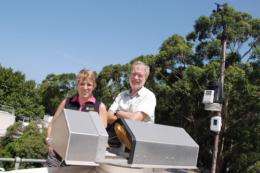Dr Murphy and Professor Griffith with the suntracker of the solar Fourier transform spectrometer that backed surprising satellite readings linking most formic acid emissions from forests
(PhysOrg.com) -- Satellites showing that nature is responsible for 90% of the earth’s atmospheric acidity shocked researchers from the Belgian Institute for Space Aeronomy, whose findings have just been published in the journal Nature Geoscience.
Stunned, the scientists approached a team from the University of Wollongong’s Centre of Atmospheric Chemistry (CAC) to confirm what satellite readings were telling them.
By providing data from a ground-based solar Fourier transform spectrometer instrument at the University, CAC used 15-years worth of information to verify the satellite’s story: all existing global models had substantially misjudged the main source of formic acid levels on earth – its forests.
UOW Physical Chemistry lecturer Dr Clare Murphy (Paton-Walsh) made the first measurements of formic acid with the instrument as part of her PhD looking at the atmospheric emissions of bushfires.
“The instrument provides a spectral record, of which you can analyse for a whole number of different gases, and formic acid is one that is relatively new,” Dr Murphy said.
“The modelling shows, particularly, that natural forest emissions have been highly underestimated. Our forest areas are producing more formic acid than we ever thought,” she said.
Dr Murphy said the unexpected results might well mean forests are responsible for most of the acidity in rainwater in areas other than highly-polluted inner-cities.
“Our instrumentation has global significance because the number of facilities in the region are very limited. In order to capture some of the major forests of the Southern Hemisphere this machine was crucial,” she said.
In the atmosphere, formic acid impacts a number of important pH-sensitive chemical reactions such as the production and loss of radicals affecting the ozone. Quickly absorbed by microbes, formic acid is not associated with the harmful effects of acid rain.
According to CAC coordinator and co-contributor Professor David Griffith, the results provide a whole new angle to existing knowledge about our atmosphere.
“When it comes to understanding the fundamental chemistry that goes on and the whole oxidiative cycle, where formic acid has an important impact is that it is one component of the soup which controls the ability of the atmosphere to oxidise pollutants and get rid of them,” Professor Griffith said.
“Normally you take your measurements and might make a 10 or 20 percent adjustment to an estimate of a source but here we’ve proven by several factors that our understanding was wrong,” he said.
The study showed that terrestrial vegetation accounts for 90 percent of annual formic acid production. Other sources include fossil fuel combustion, agriculture and biomass burning.
Provided by University of Wollongong























